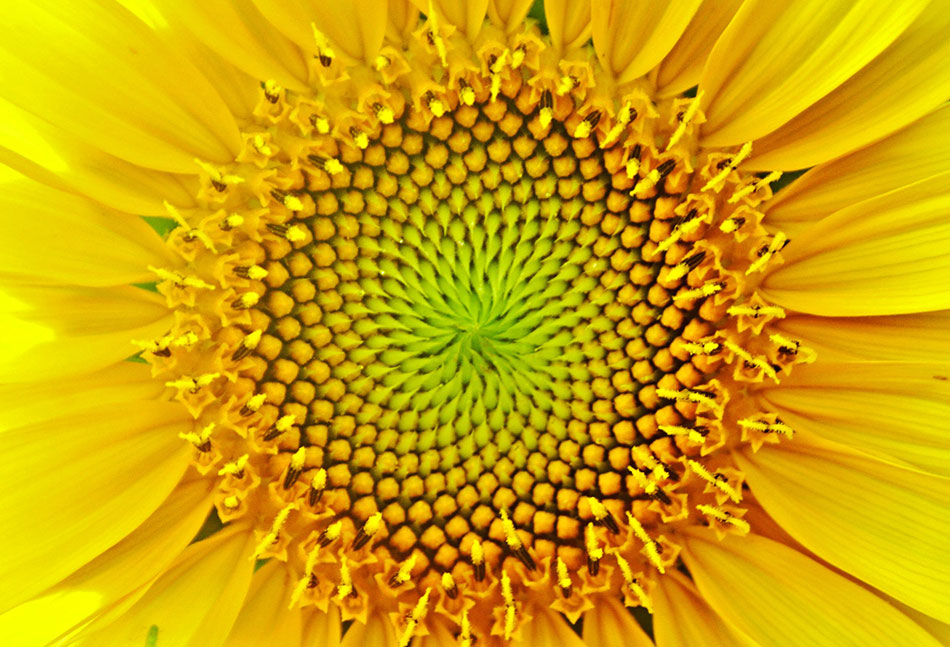It is a common belief that nature can be understood using mathematics. Many scientists have discovered mathematical concepts and patterns in nature for example from sunflowers to snowflakes to hurricanes and galaxies.
Symmetry
A great example of mathematical concepts in nature is symmetry which is found in abundance in the natural world. A snowflake exhibits a six-fold radial symmetry with unique and identical patterns on each arm. Each snowflake is different as when they fall from the sky, each experiences its own unique atmospheric conditions such as humidity and wind, which ultimately affect how the crystals on the snowflake forms. Due to each arm of the snowflake experiencing the same environmental conditions, it crystallises in the exact same way, producing a symmetrical snowflake.
Honeycombs are an example of wallpaper symmetry. It is believed by mathematicians that bees build their honeycombs in a hexagonal pattern as it is the best shape for storing the greatest amount of honey while using the least amount of wax to create the structure.
Orb spiders build their webs using radial symmetry. They create near-perfect circular webs that have near-equal-distanced radial supports coming out of the middle and a spiral that is woven to catch prey. Scientists believe that these spiders build their webs in this way for strength and to evenly distribute the force of impact when a fly or other prey becomes entangled in the web.
Symmetry in nature appears to have multiple benefits.
The Fibonacci Sequence
There is a simple sequence of numbers that appears in many places in nature called the Fibonacci sequence. Named after Leonardo of Pisa, also known as Fibonacci. This sequence of numbers involves starting at 0 then 1 and adding the previous two number together to get the next digit in the sequence, ultimately equating to 0 1 1 2 5 8 13 21 34 and so on.
The Fibonacci Spiral

The pattern in sunflower seeds and many other flowers are arranged in a Fibonacci spiral which keeps the seeds uniformly distributed regardless of the size of the seeds. “A Fibonacci spiral is a series of connected quarter-circles drawn inside an array of squares with Fibonacci numbers for dimensions. The squares fit perfectly together because of the nature of the sequence, where the next number is equal to the sum of the two before it.” (Live Science, 2017) – see diagram opposite. The spirals pack florets as tight as can be, maximising their ability to gather sunlight for the plant.
 The Fibonacci spiral can be found in many different places in nature for example the spiral is very evident in the chambers of a nautilus shell. The spiral occurs as the shell grows outwards and tries to maintain its proportional shape. The benefit of the nautilus’s growth pattern allows it to maintain its shape throughout its entire life.
The Fibonacci spiral can be found in many different places in nature for example the spiral is very evident in the chambers of a nautilus shell. The spiral occurs as the shell grows outwards and tries to maintain its proportional shape. The benefit of the nautilus’s growth pattern allows it to maintain its shape throughout its entire life.
In some plants, the leaves appear to be arranged in a Fibonacci spiral. The reason behind the staggered leaves in a spiral shape is to maximise the space each leaf has and to ensure the greatest absorption of sunlight for the plant’s growth.
Therefore, maths is everywhere in nature and has a specific purpose, either to ensure a snowflake is strong enough, a plant receives optimum conditions or even for structural purposes to save waste. Nature is spectacular in the way it uses mathematical concepts to create its own benefits.
References
Fibonacci in Nature. 2017. Fibonacci in Nature. [ONLINE] Available at:http://jwilson.coe.uga.edu/emat6680/parveen/fib_nature.htm. [Accessed 31 October 2017].
Live Science. 2017. What is the Fibonacci Sequence?. [ONLINE] Available at: https://www.livescience.com/37470-fibonacci-sequence.html. [Accessed 31 October 2017].
Planet Dolan | Obscure Facts About Life. 2017. 15 Beautiful Examples of Mathematics in Nature – Page 2 – Planet Dolan | Obscure Facts About Life. [ONLINE] Available at: http://www.planetdolan.com/15-beautiful-examples-of-mathematics-in-nature/2/. [Accessed 31 October 2017].


